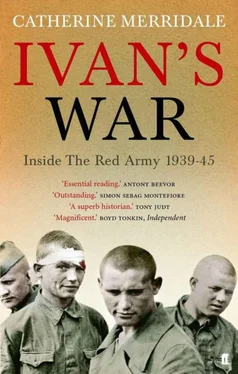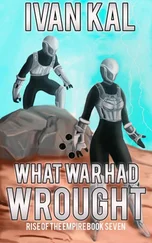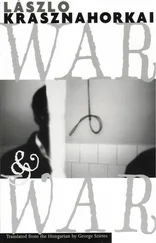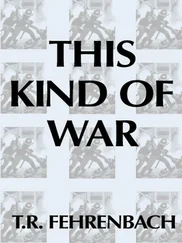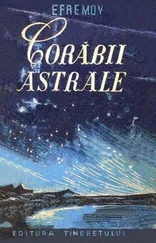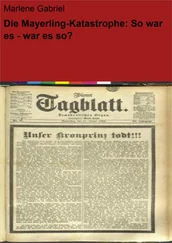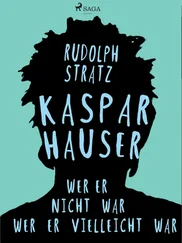30 This democratic army – or quasi-democratic one – is the subject of Mark von Hagen’s Soldiers in the Proletarian Dictatorship: The Red Army and the Soviet Socialist State, 1917–1930 (Ithaca and London, 1990).
31 David Samoilov, ‘Lyudi odnogo varianta: Iz voennykh zapisok’, part 2, Avrora, 1990, no. 2, p. 51.
32 See Bartov’s important book The Eastern Front, 1941–45: German Troops and the Barbarisation of Warfare (London, 1985).
33 First discussed in the 1940s, the theory was placed in the policy agenda by the work of Shils and Janowitz, op. cit .
34 This argument is developed in Omer Bartov, Hitler’s Army .
35 See Chapters 3 and 4.
36 Beevor, Stalingrad , p. 173.
37 The problem did concern post-war authorities. See Vera S. Dunham, In Stalin’s Time: Middleclass Values in Soviet Fiction (Cambridge, 1976), especially pp. 214–24.
1
Marching with Revolutionary Step

Whenever people think that they will have to fight a war, they start to try to picture what it will be like. Their stories seldom correspond to reality, but forecasting is not the purpose. Instead, the idea that the boys will soon be back or that the enemy will be destroyed with surgical precision, like the myth that it will all be over by Christmas, serve to foster a confident, even optimistic, mood at times when gloom might be more natural. In 1938, as the momentum for large-scale war gathered, the citizens of Stalin’s empire, like Europeans everywhere, attempted to allay their fears with comforting tales. The Soviet vision of future conflict was destined to inspire a generation of wartime volunteers, but the images were created deliberately by a clique of leaders whose ideology had set them on the path to international hostilities. The favoured medium of communication was the cinema. The epic struggle of utopia and backwardness played out in moving pictures, black and white. Stirring music reinforced the mood. At other moments, Soviet people opened their newspapers to columns of portentous diplomatic reportage; their country was preparing for battle. But though the news that citizens could read was full of threat, films were designed to inculcate the view that the people’s vanguard, the Red Army, was certain to triumph.
The greatest epic of the time was Sergei Eisenstein’s Alexander Nevsky , an anti-fascist parable of Russian victory over German invaders. Although it was set in the thirteenth century, in the age of Slavic princes and Teutonic knights, Eisenstein’s great spectacle, released in 1938, made direct reference to the politics of the 1930s, even to the point of adding swastikas to some of the Teutonic knights’ shields and standards. The message was not one that Soviet audiences, attuned to every nuance of state-controlled propaganda, would miss. For all its deliberate sermonizing, however, the film, which boasted a musical score by Sergei Prokofiev, was destined to endure as a classic of Soviet cinema. Inferior productions with similar themes have stood the test of time less well, but in the 1930s, their audiences were rapt. On the surface at least, Alexander Nevsky was set in the deep past. For cinema-goers who preferred to look forwards, another film, Efim Dzigan’s If There Is War Tomorrow , also released in 1938, foretold Russia’s victory in the face of a future invasion, the one that kept people awake at nights.
Efim Dzigan set out to reassure. The impact of his hour-long film was created by blending fictitious action with clips of genuine newsreel, splicing documentary footage into an unfolding fantasy of effortless victory. The message – resolute and stoical but also full of hope – was strengthened by the repetition of a musical refrain with words by the popular songwriter Vasily Lebedev-Kumach. 1 If There Is War Tomorrow struck so live a chord with Soviet audiences that they went on watching it after the real war began. By the winter of 1941, the invader had overrun a third of Soviet territory. The planes that droned across Dzigan’s black-and-white screen had been destroyed, the tanks burned out, the brave soldiers corralled in prison camps. It was no longer possible to dream that this war would be over soon. That winter, the audiences crowding into old schoolrooms and empty huts included evacuees from Ukraine and Smolensk, people whose homes were now in German hands. As they huddled together, relying on each other’s breath for warmth, they needed patience as the hand-cranked dynamo was turned. But all the same, a spell seemed to be cast. 2This film was not about the war, but faith. That faith, and the images that sustained it, was part of what defined the generations that would bear the brunt of Russia’s war. In the terrible years ahead, people would hum the music from this film to keep their spirits up. As they marched across dusty steppe, as they strummed a guitar by the light of a campfire, it would be Lebedev-Kumach’s song that soldiers often sang.
The film’s action opens in a fairground, probably the newly opened Gorky Park, Moscow’s Park of Culture and Rest. The Kremlin towers are visible in the distance, each topped with a glowing electric star. It is night, but the city is full of jollity, with ferris wheels and fireworks and young people strolling about with ice creams in their hands. This is the socialist paradise, and it is a place of well-earned leisure, happy couples, brightly coloured food. There is an innocence about it, crimeless, sexless, blandly without sin. In this land, Stalin and his loyal aides do all the worrying so that the children of the revolution can be free. But their freedom is under threat. The film cuts to the Soviet border, where fascist troops, ant-like, are climbing into tanks. There is no chance that we will sympathize with them. These are not the seductive species of villain but absurd buffoons. Their officers wear large moustaches, look pompous, and move with the bow-legged gait of cavalrymen. The infantrymen crawl, the airmen stoop. Throughout the action they speak German, but they are more like cartoon Prussians from a children’s book than leather-booted Nazis. Even the swastikas on their helmets and collars are slightly eccentric. This is picture-book fascism, not the real thing.
The invasion takes place at night. It could be frightening, and we may briefly worry for the stout young woman who is making soup a stone’s throw from the front, but border guards hold the aggressor at bay. Our housewife joins the men, throwing off her apron and taking her place in the line of skilful gunners, proving that patriots can turn their hands to anything. Unfortunately, however, this is just the beginning of a series of perfidious attacks. The next comes from the air. The fascist biplanes buzz with menace, but danger is averted for a second time. Soviet planes, a fleet of shining new machines, take to the skies, and at this point the audience should recognize the aces that have rushed to pilot them. There is Babushkin, the hero of an Arctic rescue mission several years before, and Vodopyanov and Gromov, flying stars, their names printed across the screen in case we did not manage to identify their faces straight away. The 1930s were the age of heroes, and pilots were the true élite. In a scene whose irony would become apparent three years later, when the Luftwaffe carried out its devastating attacks of June and July 1941, the famous aces run audacious raids into the fascists’ lair, destroying enemy aircraft on the ground and flying home without a single loss.
And now it is the Red Army’s own turn. The volunteers stream in from every corner of the Soviet land. There is an old man with a grey beard in the queue at the recruitment point. He fought against the white general, Denikin, in the civil war and now he wants to crush the enemy again. He holds a fist towards the screen, assuring us that the enemy ‘will remember this from last time’. The fascists, like the whites, have become the sworn enemies of right-thinking citizens everywhere. But not all citizens are fit to fight, and we now learn that front-line service is to be regarded as a privilege. Working and waiting are the lot of older people and the very young. Some women will remain at home, too, but others, every bit as trained and warlike as the men, line up in uniform, jaws set, prepared to do great deeds. It is not just Russians who come forward. The Commissar for Defence, Kliment Voroshilov, appears in his best uniform and appeals to the peoples of the east, the Uzbeks in particular. Hardbitten men in sheepskin hats respond at once. Voroshilov’s speech becomes a turning point for everyone. Soon Soviet troops will move into attack, driving the fascists from their trenches. The war is going to be fought on the aggressor’s soil, and it is going to be won.
Читать дальше
